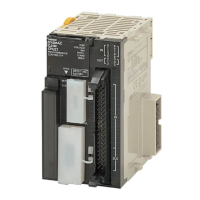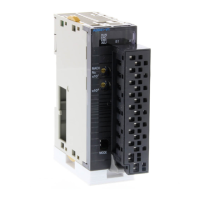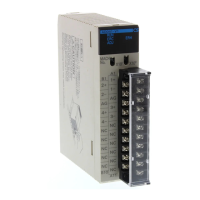126
tion, the status to be put into the register, the shift pulse, and the reset input.
The control word is allocated as follows:
15 14 13 12 Not used.
Shift direction
1 (ON): Left (LSB to MSB)
0 (OFF): Right (MSB to LSB)
Status to input into register
Shift pulse bit
Reset
The data in the shift register will be shifted one bit in the direction indicated
by bit 12, shifting one bit out to CY and the status of bit 13 into the other end
whenever SFTR(84) is executed with an ON execution condition as long as
the reset bit is OFF and as long as bit 14 is ON. If SFTR(84) is executed with
an OFF execution condition or if SFTR(84) is executed with bit 14 OFF, the
shift register will remain unchanged. If SFTR(84) is executed with an ON
execution condition and the reset bit (bit 15) is OFF, the entire shift register
and CY will be set to zero.
Flags ER: St and E are not in the same data area or ST is greater than E.
Indirectly addressed DM word is non-existent. (Content of *DM word
is not BCD, or the DM area boundary has been exceeded.)
CY: Receives the status of bit 00 of St or bit 15 of E, depending on the
shift direction.
In the following example, IR 00005, IR 00006, IR 00007, and IR 00008 are
used to control the bits of C used in @SHIFT(84). The shift register is be-
tween LR 20 and LR 21, and it is controlled through IR 00009.
00000 LD 00005
00001 OUT 05012
00002 LD 00006
00003 OUT 05013
00004 LD 00007
00005 OUT 00514
00006 LD 00008
00007 OUT 05015
00008 LD 00009
00009 @SFT(10)
050
LR 20
LR 21
05012
00005
05013
05014
05015
00006
00007
00008
00009
Direction
Status to input
Shift pulse
Reset
@SFTR(84)
050
LR 20
LR 21
Address Instruction Operands
Example
Data Shifting Section 5-13

